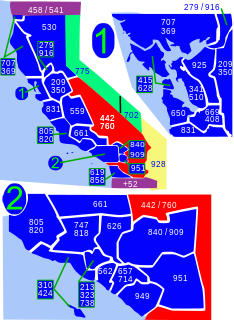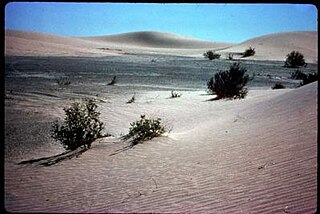Lost Lake | |
|---|---|
| Coordinates: 34°00′44″N114°28′27″W / 34.01222°N 114.47417°W Coordinates: 34°00′44″N114°28′27″W / 34.01222°N 114.47417°W | |
| Country | United States |
| State | California |
| County | Riverside |
| Elevation | 318 ft (97 m) |
| Time zone | UTC-8 (Pacific (PST)) |
| • Summer (DST) | UTC-7 (PDT) |
| ZIP codes | 92225 |
| Area code(s) | 760/442 |
| GNIS feature ID | 245216 [1] |
| Website | http://www.lostlakeriverresort.com/ |
Lost Lake (also known as Lost Lake Resort and Lost Lake Landing) is a desert community located along the west shore of the Colorado River. It also lies along U.S. Route 95 near the northeastern extent of Riverside County. Official U.S. Geological Survey feature ID is 245216 and NAD27 coordinates for the community are 34°00′44″N114°28′27″W / 34.01222°N 114.47417°W . The community lies at the foot of Riverside Mountain, 34°00′49″N114°30′45″W / 34.01361°N 114.51250°W , with a summit measuring 2,127 feet. The community is named for a lake, Lost Lake, located at 34°01′20″N114°28′21″W / 34.02222°N 114.47250°W .

In law, an unincorporated area is a region of land that is not governed by a local municipal corporation; similarly an unincorporated community is a settlement that is not governed by its own local municipal corporation, but rather is administered as part of larger administrative divisions, such as a township, parish, borough, county, city, canton, state, province or country. Occasionally, municipalities dissolve or disincorporate, which may happen if they become fiscally insolvent, and services become the responsibility of a higher administration. Widespread unincorporated communities and areas are a distinguishing feature of the United States and Canada. In most other countries of the world, there are either no unincorporated areas at all, or these are very rare; typically remote, outlying, sparsely populated or uninhabited areas.

The Colorado River is one of the principal rivers in the Southwestern United States and northern Mexico. The 1,450-mile-long (2,330 km) river drains an expansive, arid watershed that encompasses parts of seven U.S. and two Mexican states. Starting in the central Rocky Mountains of Colorado, the river flows generally southwest across the Colorado Plateau and through the Grand Canyon before reaching Lake Mead on the Arizona–Nevada border, where it turns south toward the international border. After entering Mexico, the Colorado approaches the mostly dry Colorado River Delta at the tip of the Gulf of California between Baja California and Sonora.

U.S. Route 95 (US 95) is a north–south U.S. highway in the western United States. Unlike many other US highways, it has not seen deletion or replacement on most of its length by an encroaching Interstate highway corridor, due to its mostly rural course. Because of this, it still travels from border to border and is a primary north–south highway in both Nevada and Idaho. This is one of the only US Routes or Interstate highways to cross from Mexico to Canada.
Contents
The area has been assigned to part of the 92225 ZIP Code, which it shares with Blythe. The Census Bureau designates this area as rural. The area is part of the Lost Lake Directory Area in area code 760 and is included in the Mojave Desert Air Quality Management District.

Blythe is a city in Riverside County, California, United States, in the Palo Verde Valley of the Lower Colorado River Valley region, an agricultural area and part of the Colorado Desert along the Colorado River, approximately 224 miles (360 km) east of Los Angeles and 150 miles (240 km) west of Phoenix. Blythe was named after Thomas H. Blythe, a San Francisco financier, who established primary water rights to the Colorado River in the region in 1877. The city was incorporated on July 21, 1916. The population was 20,817 at the 2010 census.

Area code 760 is a California telephone area code that was split from area code 619 on March 22, 1997. Area code 442 is an overlay of 760 that became effective on November 21, 2009. It encompasses much of the southeastern and southernmost portions of California. The area includes Imperial, Inyo, and Mono counties, as well as portions of San Diego, Riverside, San Bernardino, Los Angeles and Kern counties.
The State Department of Fish and Game has been studying elf owl populations in the area.

The elf owl is a member of the owl family Strigidae, that breeds in the southwestern United States and Mexico. It is the world's lightest owl, although the long-whiskered owlet and the Tamaulipas pygmy owl are of a similarly diminutive length. It is also the world's smallest owl. The mean body weight of this species is 40 g (1.4 oz). These tiny owls are 12.5 to 14.5 cm long and have a wingspan of about 27 cm (10.5 in). Their primary projection extends nearly past their tail. They have fairly long legs and often appear bow-legged. They can often be heard calling to one another just after dusk or at sunset. Their call is a high-pitched whinny or chuckle. The male and female dart around trees and call back and forth.
This community is part of the Colorado River Indian Reservation (USGS feature 22753). The reservation was established on March 3, 1865. According to the National Geographic Names Database, residents are primarily Hualapai, Yavapai, Navajo, and Hopi.













